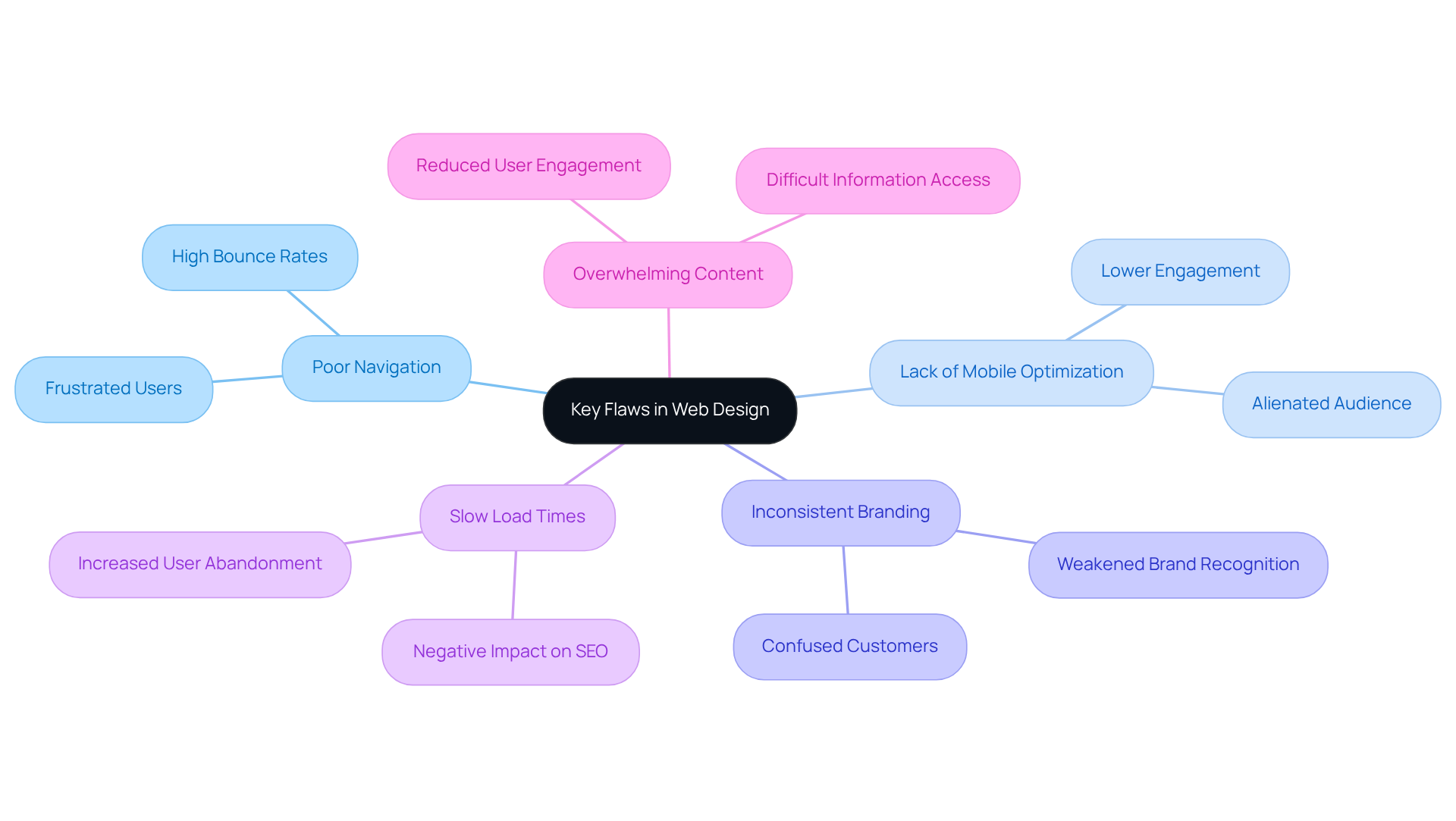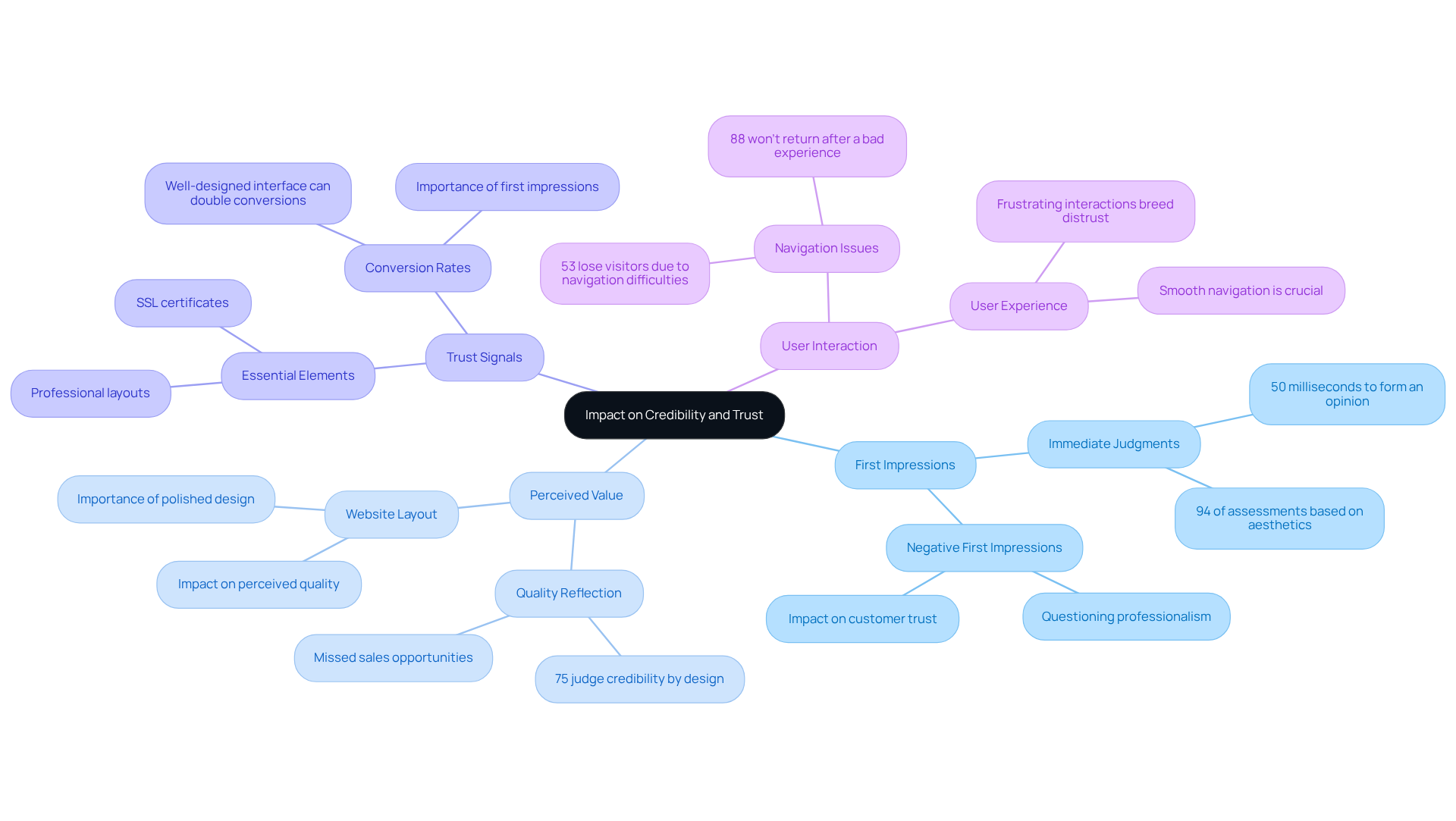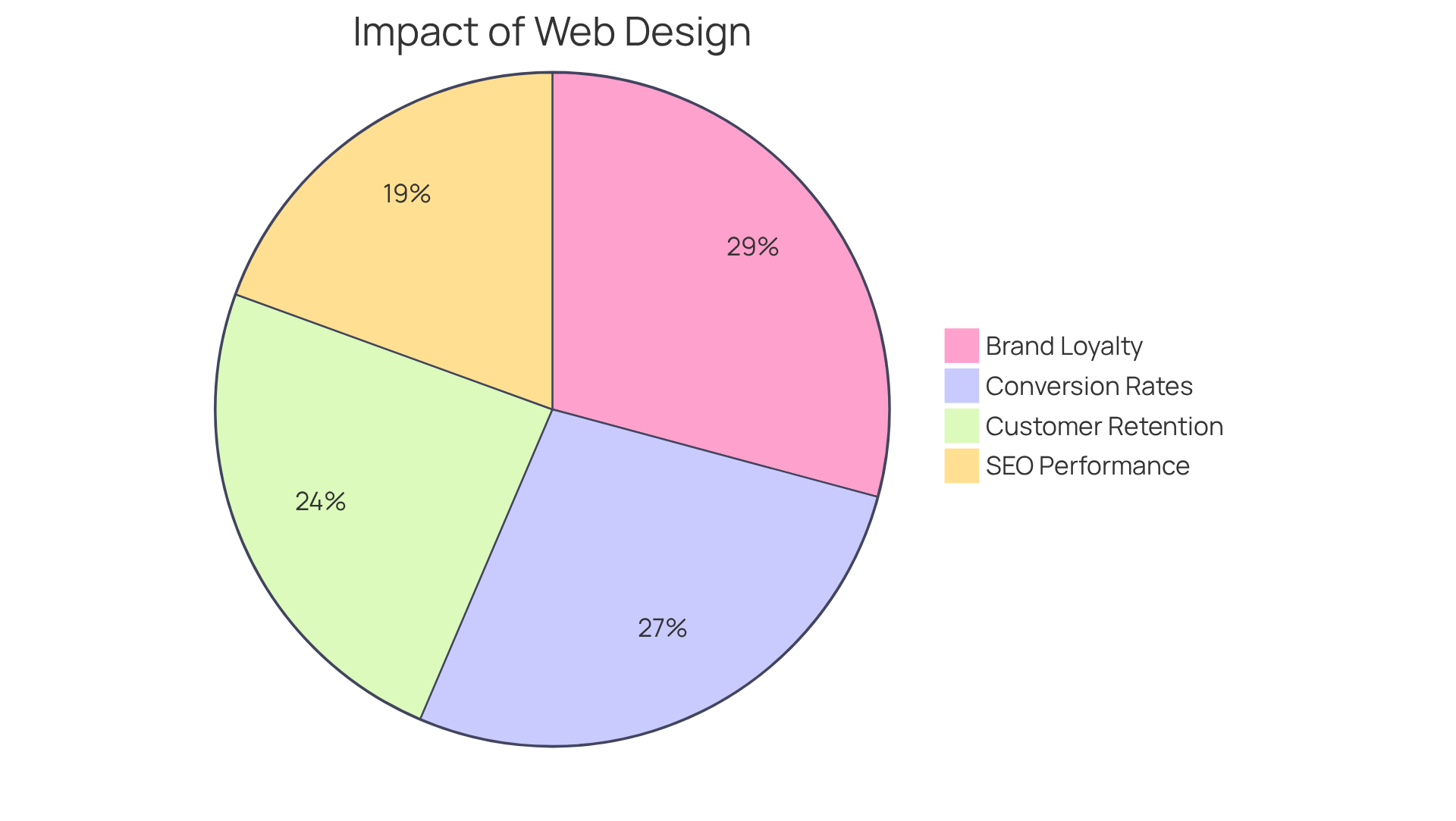Overview
Bad web design can be a significant hurdle for startups, often leading to frustrating user experiences and undermining credibility. This can have serious implications for essential business metrics, including conversion rates and customer retention. Many startup founders have faced the challenges of:
- Poor navigation
- A lack of mobile optimization
- Slow load times
These issues not only contribute to high bounce rates but can also erode trust, making it harder to grow in a competitive market.
We understand how disheartening it can be to pour your heart into a startup only to face these obstacles. It’s crucial to recognize that these design flaws can stifle your growth and success. However, there is hope. By prioritizing user experience and optimizing your website, you can turn these challenges into opportunities for improvement. With the right support and expertise, your startup can thrive, gaining the trust and loyalty of your customers.
At RNO1, we are here to help you navigate the complexities of web design, ensuring that your startup not only meets but exceeds user expectations. Together, we can create a digital presence that resonates with your audience and drives your success forward.
Introduction
In an increasingly digital world, the design of a startup's website can truly make or break its journey toward success. Poor web design not only frustrates users but also erodes a brand's credibility, leading to lost opportunities and diminished trust.
As startup founders, you may find yourselves grappling with the complexities of building your online presence. It’s essential to confront the pressing question: how do the common pitfalls of web design affect your growth and customer engagement?
Understanding these challenges is vital for crafting a compelling web experience that resonates with your audience and drives your business forward. Together, we can navigate these hurdles and create a nurturing online environment that fosters connection and success.
Identify Key Flaws in Web Design
In the fast-paced digital landscape, many startups find themselves grappling with critical aspects of bad web design that can profoundly affect their success. It’s easy to overlook these elements, but doing so can lead to significant challenges. Let’s explore some common pitfalls:
- Poor Navigation: When menus are complicated and pathways unclear, users can quickly become frustrated, leading to high bounce rates. Research shows that about 40% of people will leave a site if it isn’t mobile-friendly. This highlights just how crucial intuitive navigation is for a positive user experience.
- Lack of Mobile Optimization: As mobile internet usage continues to soar, failing to optimize for mobile can alienate a large portion of your audience. A well-optimized mobile site can keep visitors engaged longer and boost conversion rates, as users expect seamless interactions across all devices.
- Inconsistent Branding: A disjointed visual identity can confuse potential customers and weaken brand recognition. Maintaining consistency in branding across all platforms is essential for fostering trust and recognition.
- Slow Load Times: Did you know that websites taking longer than three seconds to load may see a 32% increase in visitors leaving? Fast load times are vital for keeping visitors on your site and improving search engine rankings.
- Overwhelming Content: Excessive text or cluttered layouts can overwhelm visitors, making it hard for them to find the information they need. Simplifying content and using clear calls to action can significantly enhance the user experience.
By recognizing these flaws, startups can take proactive steps to improve their web layout, preventing a bad web presence and leading to a more effective online presence. For instance, case studies reveal that companies like EcoFoil saw an 86% increase in purchases after optimizing their homepage layout. This illustrates the of addressing these layout concerns.
We understand how overwhelming it can be to navigate these challenges, but by taking the right steps, you can create a web presence that truly resonates with your audience. Remember, you’re not alone in this journey, and there are solutions available to help you succeed.

Assess Impact on Credibility and Trust
The impact of a bad web presence on a startup's credibility and trust is significant and deeply felt. Many users form immediate judgments about a brand based on their first interactions with its website, making the following factors essential to consider:
- First Impressions Matter: A website that lacks aesthetic appeal or functionality can evoke negative first impressions. This leads potential customers to question the brand's professionalism and reliability due to a bad web presence. Research shows that individuals develop opinions in as little as 50 milliseconds, with 94% of these assessments relying solely on aesthetics.
- Perceived Value: The quality of an online platform often mirrors the perceived quality of the products or services offered. A bad web layout can reduce perceived value, leading to missed sales opportunities. In fact, 75% of consumers judge a business's credibility based on its website design, underscoring the importance of a polished online presence.
- Trust Signals: Trust signals, such as SSL certificates, professional layouts, and intuitive interfaces, are vital for establishing credibility. When these elements are absent, it , creating a bad web that makes individuals hesitant to engage with the brand. A well-designed interface can double conversion rates, highlighting how crucial first impressions are in building trust.
- User Interaction: A frustrating interaction can breed distrust. If users encounter difficulties navigating a platform or finding information, they may perceive the brand as a bad web or unreliable. Statistics reveal that 88% of users will not return to a bad web after a negative experience, highlighting the importance of smooth navigation and a user-friendly layout.
By recognizing these challenges, startups can understand the importance of investing in quality web aesthetics. This investment not only cultivates trust but also enhances credibility in a competitive market. Remember, every detail matters, and creating a welcoming online space can make all the difference.

Evaluate Effects on Business Metrics and Growth
The repercussions of insufficient web creation extend far beyond mere aesthetics; they profoundly influence essential business metrics and growth trajectories. Many tech startup founders face the challenge of having a bad web design, which can be disheartening. This issue affects key areas such as:
- Conversion Rates: When design falls short, conversion rates can significantly diminish. Users may or fail to complete desired actions due to frustration or confusion. It's disheartening to note that studies show more than 70% of consumers leave their carts when the interface lacks intuitiveness. This highlights the importance of a user-friendly layout. For instance, RNO1's collaboration with RentMethod, which aided their acquisition by Airbnb, beautifully illustrates how a well-executed design can enhance engagement and conversion rates.
- Customer Retention: A poor interaction can lead to increased churn rates. Clients are less likely to revisit a site that is hard to navigate or visually unattractive. In fact, 62% of users indicate that a bad web mobile interaction makes them less likely to buy from a company again. This underscores the essential connection between user satisfaction and customer loyalty. RNO1's partnership with Spring Labs serves as a testament to how innovative digital interactions can cultivate customer retention and loyalty in competitive markets.
- SEO Performance: Search engines prioritize user-friendly websites, indicating that a bad web layout can adversely affect SEO rankings, reducing visibility and organic traffic. A well-optimized user experience is crucial, as search engines increasingly consider factors like site speed and mobile usability when ranking sites. RNO1's efforts with Amount to develop their Digital Product Creation Experience exemplify the importance of integrating UX planning with SEO strategies to enhance online visibility.
- Brand Loyalty: Consistent and attractive website aesthetics foster brand loyalty, encouraging repeat visits and customer engagement. Conversely, neglecting aesthetics can lead to a decrease in returning clients. Remarkably, 75% of users form their impression of a company based on its website appearance within just 50 milliseconds.
By assessing these effects, startups can gain a deeper understanding of the vital role that effective web design plays in driving business success, especially when considering the consequences of bad web design on sustainable growth. Remember, you are not alone in this journey; RNO1 is here to support you in creating a web presence that resonates with your audience and drives meaningful results.

Conclusion
Bad web design can be a significant barrier to a startup's success, affecting everything from user experience to brand credibility. Many founders face the frustration of poor navigation, lack of mobile optimization, and slow load times, which can detract from their vision. By addressing these common flaws, startups can cultivate a more engaging and effective online presence. This proactive approach not only enhances user satisfaction but also fosters trust and encourages customer loyalty.
Key insights reveal that a well-designed website can dramatically improve conversion rates, strengthen brand identity, and boost overall business performance. It's crucial to note that a significant percentage of users judge a brand's credibility based on its website design. This underscores the importance of investing in quality web aesthetics. By recognizing the deep connection between web design and business metrics, startups can make informed decisions that pave the way for sustainable growth.
Ultimately, we cannot overstate the significance of good web design. It serves as a critical foundation for establishing credibility, enhancing user experience, and driving business success. We encourage startups to prioritize their web presence, as the benefits of a well-optimized site extend far beyond aesthetics. It influences customer perceptions and engagement in profound ways. Taking action now can truly pave the way for a thriving digital future. Together, let’s embrace the journey of creating a compelling online presence that resonates with your audience.
Frequently Asked Questions
What are some common pitfalls in web design that startups should avoid?
Common pitfalls include poor navigation, lack of mobile optimization, inconsistent branding, slow load times, and overwhelming content.
Why is navigation important in web design?
Intuitive navigation is crucial because complicated menus and unclear pathways can frustrate users, leading to high bounce rates. About 40% of people will leave a site if it isn’t mobile-friendly.
How does mobile optimization affect user engagement?
Failing to optimize for mobile can alienate a large portion of the audience, while a well-optimized mobile site can keep visitors engaged longer and boost conversion rates.
What impact does inconsistent branding have on a business?
A disjointed visual identity can confuse potential customers and weaken brand recognition, making it essential to maintain consistency across all platforms.
How do slow load times affect website traffic?
Websites that take longer than three seconds to load may see a 32% increase in visitors leaving, making fast load times vital for retaining visitors and improving search engine rankings.
What is the effect of overwhelming content on user experience?
Excessive text or cluttered layouts can overwhelm visitors, making it difficult for them to find necessary information. Simplifying content and using clear calls to action can enhance the user experience.
Can improving web design lead to increased sales?
Yes, for example, case studies show that companies like EcoFoil experienced an 86% increase in purchases after optimizing their homepage layout, highlighting the benefits of addressing layout concerns.




